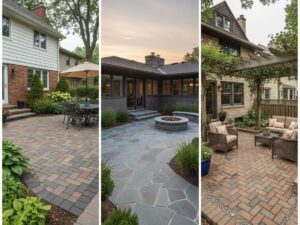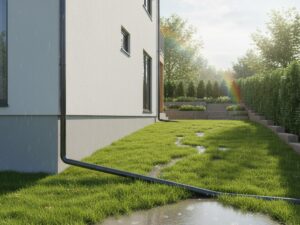French drains and dry wells are two of the most reliable options for managing unwanted water in your yard. These yard drainage solutions counter excess moisture in different ways. French drains redirect water across your landscape, while dry wells allow it to soak into the ground safely. Now, choosing the right system amidst these two depends on your yard’s layout, soil type, and where water tends to collect, but how do you know which one is right for you?
In this blog, we’ll dive into how French drains and dry wells work, when to use them, and which system offers the most value for your specific yard layout. By the end, you’ll know exactly what your yard needs and what the best options are for your home.
What are French Drains and Dry Wells?
French drains and dry wells are two widely used landscape drainage solutions, each built to handle water issues in different ways.
French Drains
A French drain backyard system involves a gently sloped trench fitted with a perforated pipe and surrounded by gravel. As excess water seeps into the soil, it enters the pipe and is channeled away from problem areas, such as foundations, patios, or low-lying lawn sections. This method is particularly effective in yards with poor grading or heavy surface runoff.
Dry Wells
A dry well is an underground reservoir usually filled with rock or a durable chamber that collects and stores water from gutters, sump pumps, or surface drains. The water then gradually infiltrates into the surrounding soil, making dry wells a great fit for properties with good soil permeability and localized drainage issues.
Both options play a critical role in lawn water management, but their effectiveness depends on the source of the water and how your yard absorbs it.
French Drains vs. Dry Wells: Picking the Right Landscape Drainage Solution for Your Yard
Choosing between a French drain backyard setup and a dry well depends on several factors. Here’s a detailed breakdown to help you make a better decision:
Water Flow Direction & Drainage Style
French Drains
French drains are ideal for managing linear drainage issues, particularly where water travels downhill or accumulates along hardscapes, such as patios, foundations, or walkways. They can also be integrated with surface grates to capture runoff from compacted areas, such as driveways, and efficiently direct it away from your property.
Dry Wells
Dry wells manage water that collects in localized zones such as beneath downspouts or natural low points in the yard. These underground systems temporarily hold water, allowing it to infiltrate the soil and gradually prevent surface pooling.
Soil Suitability
French Drains
Best suited for clay-heavy or poorly draining soils, French drains physically reroute water to more absorbent areas. This makes them valuable where natural percolation is limited and standing water becomes persistent.
Dry Wells
Dry wells excel in sandy or loamy soils where permeability is already high. In well-drained environments, they can infiltrate up to 70–90% of stormwater runoff, offering an efficient and eco-friendly solution. Before deciding on a specific yard drainage solution, reviewing expert tips for removing yard standing water can help you identify visible symptoms and underlying causes of poor drainage.
Environmental & Lawn Water Management Considerations
French Drains
These systems are effective in limiting surface pooling and protecting root systems in compacted or less permeable soils. By redirecting water away from sensitive areas, they help preserve landscaping and prevent erosion.
Dry Wells
Dry wells support groundwater recharge by allowing water to seep naturally back into the earth. In permeable landscapes, they offer a more sustainable drainage strategy that improves soil health and reduces runoff.
Cost & Installation
French Drains
Installation involves trenching, pipe placement, and grading, which makes French drains more labor-intensive and costly. They offer customizable routing options, making them well-suited for larger properties or complex drainage requirements.
Dry Wells
Dry wells are less invasive and typically quicker to install. For isolated drainage issues, such as water collecting under a gutter, a dry well can serve as an effective yard drainage solution that’s both targeted and budget-friendly.
Maintenance & Durability
French Drains
To prevent sediment buildup, French drains may require occasional flushing. Installing filter fabric around the piping enhances longevity and reduces the chance of clogging over time.
Dry Wells
These systems are designed to be low-maintenance, but they benefit from the addition of sediment traps or leaf guards at the inflow point. With proper care, they maintain consistent performance for years with minimal upkeep.
Can You Combine Both?
Absolutely. A hybrid drainage system that integrates both a French drain and a dry well can be one of the most efficient yard drainage solutions for managing complex water issues. A French drain collects and redirects excess water from areas prone to pooling, such as foundations, patios, or soggy lawn sections, to protect structures and prevent erosion. That redirected water can then be funneled into a dry well, which stores and slowly disperses it into the surrounding soil.
This combined approach balances surface drainage and soil infiltration, reducing the risk of water damage while supporting sustainable water management. It’s a practical solution for larger properties or uneven terrain where water accumulates in different zones. By sharing the workload between both systems, you also increase durability and reduce the likelihood of overload or failure.
To maximize the value of a hybrid setup, it’s advisable to collaborate with a certified Yard Drainage Contractor who can evaluate your soil type, grading, and runoff patterns to design a solution specifically tailored to your landscape.
Conclusion
Now that you understand how French drains and dry wells work, individually or combined, you’re ready to make smarter decisions that can turn a waterlogged yard into a well-drained, functional space.
If you’re still unsure where to start, My Landscape Contractor is here to help. We specialize in tailored drainage solutions that address real yard problems and protect your landscape for the long term. You’ll also get expert tips for removing yard standing water, so you’re informed from the start.




